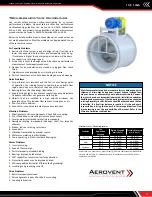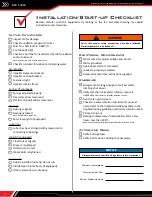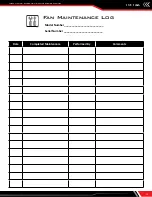
Installation, Operation & Maintenance Manual
IM-166
4
Safety & Hazard Warnings
For general safety practices for air moving equipment, see AMCA Bulletin 410. Aerovent offers many safety accessories. These safety
devices include (but are not limited to) belt guards, shaft guards, inlet and discharge screens. The use and suitability of safety devices
is the responsibility of the purchaser.
Facility related safety conditions include fans’ accessibility and location. How easily can non-service personnel access the unit? Is the
fan in a hazardous duty environment? Was the unit ordered for this duty? Other concerns must also be addressed. All fans should be
powered through controls that are easily accessible to service personnel from the fan. Fan power must have the ability to be “locked
out” by service personnel trained in lockout/tagout procedures per OSHA requirements (29CFR1910.147). When performing lockout,
be aware of factors, such as building pressure and additional fans in the system that can influence unwanted fan rotation (wind milling).
If you have any doubt about your ability to perform a task, seek a person qualified to do that task. Before any work is done on a fan,
ensure that the fan is isolated from the electrical supply using a 'lockout/tagout system.'
Note: A stationary, non-rotating fan does not mean that the fan is isolated from the electrical supply or from other fans/dampers in the
system that could cause the fan impeller to rotate. A non-rotating fan could be subject to controls or other circuit protection devices
that may start the fan without notice.
The following safety precautions should be followed, where applicable:
• Do not attempt to slow a rotating impeller even when it is isolated from the electrical supply. Fan impellers have a high inertia and
injury could result from an attempt to stop it. It is recommended that the impeller is isolated by closing off the inlet or outlet to
prevent wind-driven rotation. If an impeller is chocked to prevent rotation, ensure that the chocks are removed prior to start up.
• Wear appropriate personal protective equipment. This may include protective clothing, eye protection, ear protection, respiratory
equipment, hand and foot protection when installing or servicing the fan.
• Always use caution when entering a fan's air path. High velocity airflow can cause you to lose your balance.
• Motor, bearings and drives can be hot, and similarly if the fan is subject to processes that are hot, the fan housing could be hot.
• Fans are often used to move hazardous materials that could be dangerous. Always wear protective clothing and take precautions
not to inhale dust/gases. If hazardous chemical vapors are present, respiratory equipment may be required.
• Sharp edges – wear protective gloves when handling, installing or servicing a fan.
• Fans can operate at high decibel sound levels. Wear proper ear protection to protect from excessive noise levels.
• Access doors – Do not open access doors when fan is in operation. The effects of suction and air pressure could result in injury.
• When working around pulleys and belts, keep hands away from pinch points. This pertains to when the fan is under or off power.
Throughout this manual, there are a number of HAZARD WARNINGS that must be read and adhered to in order to prevent possible
personal injury and/or damage to equipment. Two signal words "WARNING" and "CAUTION" are used to indicate the severity of a
hazard and are preceded by the safety alert symbol. It is the responsibility of all personnel involved in installation, operation and
maintenance to fully understand the warning and caution procedures by which hazards are to be avoided.
WARNING:
Used when serious injury or death MAY result from misuse or failure to follow specific instructions.
CAUTION:
Used when minor or moderate injury or product / equipment damage MAY result from misuse or failure to follow
specific instructions.
NOTICE:
Indicates information considered important, but not hazard-related.
Shipping & Receiving
All Aerovent products are carefully constructed and inspected before shipment to ensure the highest standards of quality and
performance. Compare all components with the bill of lading or packing list to verify that the proper unit was received. Check each
unit for any damage that may have occurred in transit. Any damage should be reported immediately to the carrier and the necessary
damage report filed. Damage should be noted on the bill of lading.




































